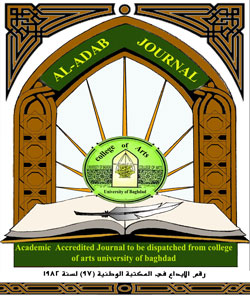Socio-Linguistic Study of National Apologies in Public Discourse
DOI:
https://doi.org/10.31973/aj.v0i134.1025Keywords:
Apologies, LinguisticAbstract
An apology is a formal and known acknowledgement that an individual uses when some individuals violate human rights, i.e., apologies emerge when human rights are violated for a reason or another.
The national apology can be defined as the type of apology that is political, collective, and intrastate which a group of people offer to another by using an appropriate representation. Though the term ‘age of apology’ first emerged two decades ago, the term ‘national apology’, even with age, has continued to be one that is specifically analytically elusive.
In contrast to interpersonal apologies that exist between individuals, a collective apology is constructed of and directed to definite communities. It is considered as political since it is made by/through political or social companies, institutions or organizations and for past wrongdoings of political characters.
Using national apology, the speaker tries to be political in his/her speech to be able to achieve his/her aim of the communication. Using different strategies, one of them is national apology, the speaker tries to avoid FTA and get the acceptable response from the audience.
The aim of this study is to analyze how the speaker uses the national apology in public discourse, the reasons, the constructions and the meaning of this kind of apologies. This study is concerned with investigating the social functions of national apologies.
Downloads
References
Behaviour. New York: Doubleday Anchor.
Blatz, Craig W.; Schumann, Karina and Ross, Micheal. (2009). Government Apologies for Historical Injustice. Political Psychology, Vol 30. No2.
Blum-Kulka, Shoshana and Olshtain, Elite (1984). Requests and Apologies: A Cross-Cultural Study of Speech Act Realization Patterns. https:\\www.reaserchgate.net/publication/31338837
Brown, Penelope and Levinson, Stephen C. (1989). Politeness: Some Universals in Language Usage. Cambridge University Press.
Carranza, Ruben; Correa, Cristian and Naughton, Elena. (2015). More than Words: Apologies as a Form of Reparation. International Centre of Transitional Justice. www.ictj.org.
Daniels, R. (2003) .An Age Of Apology? . Kingston, Ontario: Kashtan Press.
Fraser, D.R. (1981). "On Apology" in Conversational Routine. F. Coulmas (ed) pp.259-2711. The Itague Mouton.
Goffman, E . (1971). Relations in Public. New York. Harper & Row.
Goffman, E. (1967). Interaction Ritual: Essays in Face-to-Face
Historical Injustices. MSc International Political Theory. University of Edinburgh
https://glean.info/5-examples-superb-company-apologies/
https://www.americanrhetoric.com/speeches/marionjonesapologyforsteroiduse.htm
https://www.comm100.com/blog/public-apology-letter-example.html
Kaleja, Ance. (2010). The Role of National Apologies in Rectifying
Murad, Tareq Mitaib. (2012). Apology strategies in the Target Language (English) of Israeli-Arab EFL College Students Towards their Lectures of English Who are Also Native Speakers of Arabic. Studies in Literature and Language. Vol4, No3. Pp23-29.
Negash, G. (2006) Apologia Politica: States and their Apologies by Proxy. Oxford: Lexington Books.
Norrick, N. R. (1978). Expressive Illocutionary Acts. Journal of Pragmatics, 2(3), 277-291.University Press, 2009.
Olshtain, E.(1989). Apologies Across Languages. In S. Blum-Kulka, J. House & G. Kasper (eds). Cross-Cultural Pragmatics. (pp. 155-
Parchanant, Nawamin. (2016). Across-Cultural Study of Apology Speech Act Realizations. International Journal of Languages, Literature and Linguistics, Vol 3.pp.146-151.
Rakenduslingviskita Uhingu Austaraamat.
Ruzaite, Jurate. (2007). Apologies in Business Communication. Eesti
Sanz, Eneko. (2012). National Apologies: Mapping the Complexities of Validity. Practical Paper edited by Tomlinson, Jeremy. The Center for Peace and Conflict Studies.
Strange, H. (2002). Repair or Revenge: Victims and Restorative Justice. Oxford: Clarendon Press.
Downloads
Published
Issue
Section
License
Copyright and Licensing:
For all articles published in Al-Adab journal, copyright is retained by the authors. Articles are licensed under an open access Creative Commons CC BY 4.0 license, meaning that anyone may download and read the paper for free. In addition, the article may be reused and quoted provided that the original published version is cited. These conditions allow for maximum use and exposure of the work.
Reproducing Published Material from other Publishers: It is absolutely essential that authors obtain permission to reproduce any published material (figures, schemes, tables or any extract of a text) which does not fall into the public domain, or for which they do not hold the copyright. Permission should be requested by the authors from the copyrightholder (usually the Publisher, please refer to the imprint of the individual publications to identify the copyrightholder).
Permission is required for: Your own works published by other Publishers and for which you did not retain copyright.
Substantial extracts from anyones' works or a series of works.
Use of Tables, Graphs, Charts, Schemes and Artworks if they are unaltered or slightly modified.
Photographs for which you do not hold copyright.
Permission is not required for: Reconstruction of your own table with data already published elsewhere. Please notice that in this case you must cite the source of the data in the form of either "Data from..." or "Adapted from...".
Reasonably short quotes are considered fair use and therefore do not require permission.
Graphs, Charts, Schemes and Artworks that are completely redrawn by the authors and significantly changed beyond recognition do not require permission.
Obtaining Permission
In order to avoid unnecessary delays in the publication process, you should start obtaining permissions as early as possible. If in any doubt about the copyright, apply for permission. Al-Adab Journal cannot publish material from other publications without permission.
The copyright holder may give you instructions on the form of acknowledgement to be followed; otherwise follow the style: "Reproduced with permission from [author], [book/journal title]; published by [publisher], [year].' at the end of the caption of the Table, Figure or Scheme.











